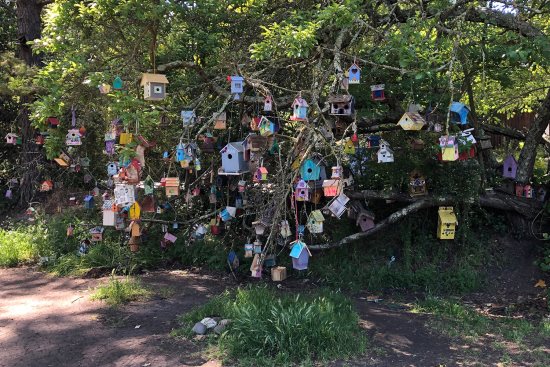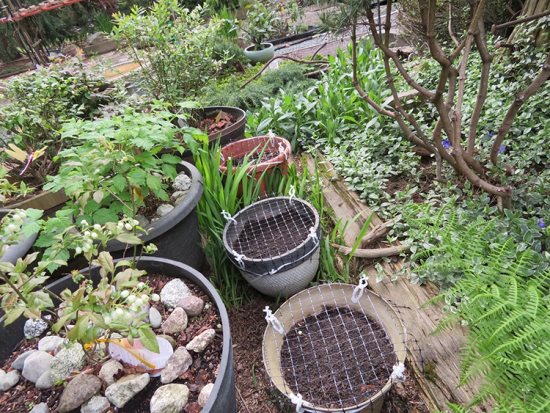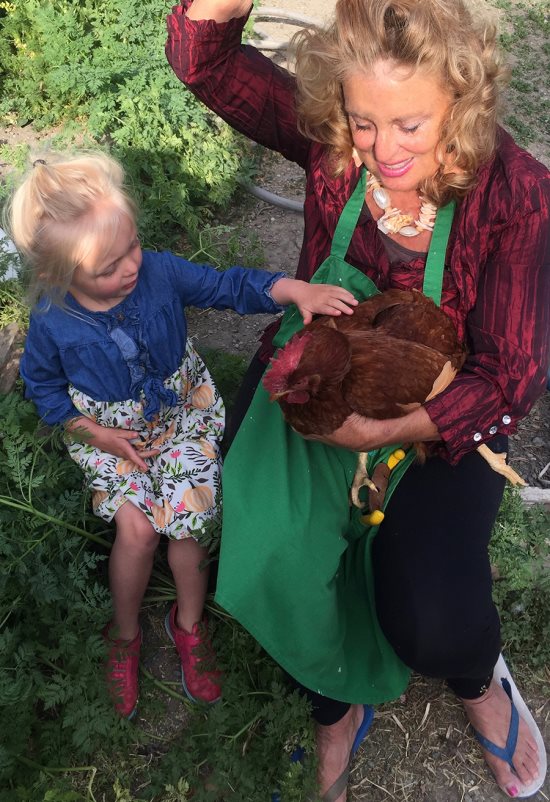 |
|
|
The bumblebee drinks nectar from a bottlebrush plant. Photos Cynthia Brian
|
|
|
|
|
|
"I rejoice when I see anyone, and especially children, inquiring about flowers, and wanting gardens of their own, and carefully working in them. For the love of gardening is a seed that once sown never dies, but always grows and grows to an enduring and ever-increasing source of happiness." - Gertrude Jekyll
 Like airplanes and cruise ships across the country, many of us continue to be grounded. As we embark on our 11th week of staying at home and online learning, adults and children are naturally a bit antsy.
Like airplanes and cruise ships across the country, many of us continue to be grounded. As we embark on our 11th week of staying at home and online learning, adults and children are naturally a bit antsy.
 When I was a kid and school was closed for whatever reason, my very first instinct was to get outside and explore. I wanted to be on the tractor plowing the fields with my dad, tending the vegetable garden with my mom, or leading the rest of the ranch kids on an adventure through the creeks and hills to identify flowers, plants, amphibians and insects.
When I was a kid and school was closed for whatever reason, my very first instinct was to get outside and explore. I wanted to be on the tractor plowing the fields with my dad, tending the vegetable garden with my mom, or leading the rest of the ranch kids on an adventure through the creeks and hills to identify flowers, plants, amphibians and insects.
 I'm certain that my love of the natural world began as a child. As an adult, I have always felt it was important to share this passion with youth. Gardens offer a crucial way for people to access and experience the natural environment. Nature is a public health resource that is available to everyone. Since it's springtime and we are all grounded, why not employ some fun activities that the entire family can enjoy together while practicing social distancing?
I'm certain that my love of the natural world began as a child. As an adult, I have always felt it was important to share this passion with youth. Gardens offer a crucial way for people to access and experience the natural environment. Nature is a public health resource that is available to everyone. Since it's springtime and we are all grounded, why not employ some fun activities that the entire family can enjoy together while practicing social distancing?
 Here are a few ideas that I've implemented with my family and students over the years.
Here are a few ideas that I've implemented with my family and students over the years.
 1. Begin a nature journal. Use a spiral binder, a notebook, or design a beautiful unique diary. Go outside and observe. Use crayons, markers, or paints to illustrate and chronicle what you see.
1. Begin a nature journal. Use a spiral binder, a notebook, or design a beautiful unique diary. Go outside and observe. Use crayons, markers, or paints to illustrate and chronicle what you see.
 2. Record nature sounds. You'll hear different sounds at various times of the day. Crickets chirping, frogs croaking, birds singing, water tricking, wind whistling, squirrels chattering, bees buzzing. Make a personal meditation recording on your smartphone.
2. Record nature sounds. You'll hear different sounds at various times of the day. Crickets chirping, frogs croaking, birds singing, water tricking, wind whistling, squirrels chattering, bees buzzing. Make a personal meditation recording on your smartphone.
 3. Underground exploration. The earth is crawling with activity. Underneath the surface of the soil, countless critters are busy at work. Go to a corner of your garden and gently dig up a trowel full of soil. What do you see? Earthworms? Millipedes? Sowbugs? Slugs? Are there spiders or other insects crawling? Note your findings in your nature journal.
3. Underground exploration. The earth is crawling with activity. Underneath the surface of the soil, countless critters are busy at work. Go to a corner of your garden and gently dig up a trowel full of soil. What do you see? Earthworms? Millipedes? Sowbugs? Slugs? Are there spiders or other insects crawling? Note your findings in your nature journal.
 4. Make a "stained glass" window. One of my favorite projects as a kid was picking pretty flowers to press. Instead of making a book, we made "stained glass" windows by pressing an arrangement of petals between two sheets of wax paper and ironing the wax paper. Make sure to place a thin dishcloth on top of the wax paper before ironing. The wax paper seals the flowers together creating a colorful window. Choose brightly colored flowers and dark green foliage that will lay flat. California poppy, bougainvillea, pansy, violets, rose petals and nasturtium work especially well. Hang them with ribbon by a window to reflect the rainbow of hues.
4. Make a "stained glass" window. One of my favorite projects as a kid was picking pretty flowers to press. Instead of making a book, we made "stained glass" windows by pressing an arrangement of petals between two sheets of wax paper and ironing the wax paper. Make sure to place a thin dishcloth on top of the wax paper before ironing. The wax paper seals the flowers together creating a colorful window. Choose brightly colored flowers and dark green foliage that will lay flat. California poppy, bougainvillea, pansy, violets, rose petals and nasturtium work especially well. Hang them with ribbon by a window to reflect the rainbow of hues.
 5. Decorate your mailbox. Plant a climbing rose or trumpet vine at your mailbox to brighten your street. You'll need to keep it shaped and pruned.
5. Decorate your mailbox. Plant a climbing rose or trumpet vine at your mailbox to brighten your street. You'll need to keep it shaped and pruned.
 6. Grow a vegetable garden. Besides the ease and rapid sprouting of beets, radishes and carrots, one of the most rewarding combinations to do with kids is to plant a Three Sisters Garden. If possible, give your child her own little plot so she will feel proud of being a farmer. The Iroquois Native Americans planted corn, beans and squash for a balanced diet. Corn is a source of carbohydrates, beans offer proteins, and squash is filled with vitamins. The corn is the pole for the beans to climb while the squash grows low to the ground providing shade and keeping the soil moist. There is nothing tastier or more nutritious than home-grown food. Make sure to plant tomatoes and peppers now.
6. Grow a vegetable garden. Besides the ease and rapid sprouting of beets, radishes and carrots, one of the most rewarding combinations to do with kids is to plant a Three Sisters Garden. If possible, give your child her own little plot so she will feel proud of being a farmer. The Iroquois Native Americans planted corn, beans and squash for a balanced diet. Corn is a source of carbohydrates, beans offer proteins, and squash is filled with vitamins. The corn is the pole for the beans to climb while the squash grows low to the ground providing shade and keeping the soil moist. There is nothing tastier or more nutritious than home-grown food. Make sure to plant tomatoes and peppers now.
 7. Plant herbs and flowers in containers. In several containers, sow seeds of your favorite herbs for seasonings. Dill, cilantro, parsley, basil, thyme or mint. Sprinkle a few flower seeds for color. Cover with wire to keep the critters and birds out, using Christmas clips to secure the wire. Decorate with rocks, shells, or other trinkets that your kids have found.
7. Plant herbs and flowers in containers. In several containers, sow seeds of your favorite herbs for seasonings. Dill, cilantro, parsley, basil, thyme or mint. Sprinkle a few flower seeds for color. Cover with wire to keep the critters and birds out, using Christmas clips to secure the wire. Decorate with rocks, shells, or other trinkets that your kids have found.
 8. Go on a tasting adventure. For this experience, an adult must know with 100% accuracy that a plant is edible because there are many toxic flowers and leaves in nature that can make us very sick or worse. This is an educational encounter that kids truly savor. Some unexpected plants that can be sampled include rose, nasturtium, fennel, calendula, dandelion, wild mustard, miner's lettuce, and the berries of Oregon Grape. Leaves and flowers of all herbs can be sampled. Make sure there are no pesticides or insecticides on any of these specimens. Record the flavors in the journal. Do you find something sweet, sour, bitter, or something else? Emphasize the importance of knowing what is edible and what is poisonous before tasting anything.
8. Go on a tasting adventure. For this experience, an adult must know with 100% accuracy that a plant is edible because there are many toxic flowers and leaves in nature that can make us very sick or worse. This is an educational encounter that kids truly savor. Some unexpected plants that can be sampled include rose, nasturtium, fennel, calendula, dandelion, wild mustard, miner's lettuce, and the berries of Oregon Grape. Leaves and flowers of all herbs can be sampled. Make sure there are no pesticides or insecticides on any of these specimens. Record the flavors in the journal. Do you find something sweet, sour, bitter, or something else? Emphasize the importance of knowing what is edible and what is poisonous before tasting anything.
 9. Scavenger Hunt. Animals are always building, hunting, gathering and scavenging. Take a walk around your backyard or a hike in the neighborhood to collect a few of nature's discarded treasures. What did you find? An empty bird's nest, twigs, acorns, feathers, bark, pinecones, or nuts? Design a natural art piece together.
9. Scavenger Hunt. Animals are always building, hunting, gathering and scavenging. Take a walk around your backyard or a hike in the neighborhood to collect a few of nature's discarded treasures. What did you find? An empty bird's nest, twigs, acorns, feathers, bark, pinecones, or nuts? Design a natural art piece together.
 10. Introduce animals. Children are naturally drawn to animals. Since grounding, I've noticed a huge uptick in people who have decided to buy newborn chickens, rabbits, birds, potbelly pigs, goats, dogs and cats to familiarize their children or grandchildren with animal husbandry. As someone who was born and raised on a farm and has always been surrounded by animals, I'm a huge proponent . with this caveat. Remember that these adorable babies grow up to be adult animals who aren't always so cuddly. They require food, water, grooming, shelter, and constant care throughout their lives. Raising any animal teaches discipline, responsibility, patience, kindness, gentleness, interdependence and love. These are all magnificent virtues. Are you ready and prepared for the long haul?
10. Introduce animals. Children are naturally drawn to animals. Since grounding, I've noticed a huge uptick in people who have decided to buy newborn chickens, rabbits, birds, potbelly pigs, goats, dogs and cats to familiarize their children or grandchildren with animal husbandry. As someone who was born and raised on a farm and has always been surrounded by animals, I'm a huge proponent . with this caveat. Remember that these adorable babies grow up to be adult animals who aren't always so cuddly. They require food, water, grooming, shelter, and constant care throughout their lives. Raising any animal teaches discipline, responsibility, patience, kindness, gentleness, interdependence and love. These are all magnificent virtues. Are you ready and prepared for the long haul?
 Gardening has many benefits for the physical and mental health of everyone in the family. According to the Centers for Disease Control and Prevention, we burn approximately 330 calories per hour of gardening. Gardening lowers our blood pressure, it reduces depression, anxiety and stress while increasing our wonder, happiness and satisfaction.
Gardening has many benefits for the physical and mental health of everyone in the family. According to the Centers for Disease Control and Prevention, we burn approximately 330 calories per hour of gardening. Gardening lowers our blood pressure, it reduces depression, anxiety and stress while increasing our wonder, happiness and satisfaction.
 For the foreseeable future, we are all grounded, but we don't have to endure a perpetual Groundhog Day. Expand the quality of daily living by proposing the joys of gardening and being one with nature to your children, teens and community. Go outside and meander.
For the foreseeable future, we are all grounded, but we don't have to endure a perpetual Groundhog Day. Expand the quality of daily living by proposing the joys of gardening and being one with nature to your children, teens and community. Go outside and meander.
 Stay healthy. Stay safe. Stay sane. Stay home.
Stay healthy. Stay safe. Stay sane. Stay home.
 Happy Gardening. Happy Growing.
Happy Gardening. Happy Growing.
|











